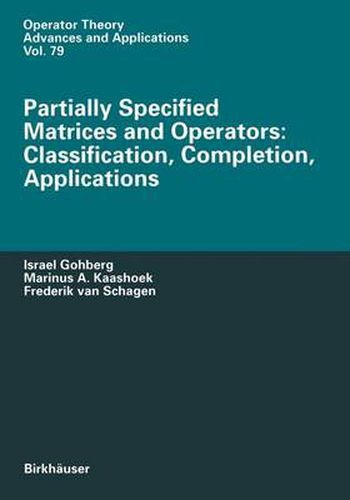Readings Newsletter
Become a Readings Member to make your shopping experience even easier.
Sign in or sign up for free!
You’re not far away from qualifying for FREE standard shipping within Australia
You’ve qualified for FREE standard shipping within Australia
The cart is loading…






This title is printed to order. This book may have been self-published. If so, we cannot guarantee the quality of the content. In the main most books will have gone through the editing process however some may not. We therefore suggest that you be aware of this before ordering this book. If in doubt check either the author or publisher’s details as we are unable to accept any returns unless they are faulty. Please contact us if you have any questions.
This book is devoted to a new direction in linear algebra and operator theory that deals with the invariants of partially specified matrices and operators, and with the spectral analysis of their completions. The theory developed centers around two major problems concerning matrices of which part of the entries are given and the others are unspecified. The first is a classification problem and aims at a simplification of the given part with the help of admissible similarities. The results here may be seen as a far reaching generalization of the Jordan canonical form. The second problem is called the eigenvalue completion problem and asks to describe all possible eigenvalues and their multiplicities of the matrices which one obtains by filling in the unspecified entries. Both problems are also considered in an infinite dimensional operator framework. A large part of the book deals with applications to matrix theory and analysis, namely to stabilization problems in mathematical system theory, to problems of Wiener-Hopf factorization and interpolation for matrix polynomials and rational matrix functions, to the Kronecker structure theory of linear pencils, and to non everywhere defined operators. The eigenvalue completion problem has a natural associated inverse, which appears as a restriction problem. The analysis of these two problems is often simpler when a solution of the corresponding classification problem is available.
$9.00 standard shipping within Australia
FREE standard shipping within Australia for orders over $100.00
Express & International shipping calculated at checkout
Stock availability can be subject to change without notice. We recommend calling the shop or contacting our online team to check availability of low stock items. Please see our Shopping Online page for more details.
This title is printed to order. This book may have been self-published. If so, we cannot guarantee the quality of the content. In the main most books will have gone through the editing process however some may not. We therefore suggest that you be aware of this before ordering this book. If in doubt check either the author or publisher’s details as we are unable to accept any returns unless they are faulty. Please contact us if you have any questions.
This book is devoted to a new direction in linear algebra and operator theory that deals with the invariants of partially specified matrices and operators, and with the spectral analysis of their completions. The theory developed centers around two major problems concerning matrices of which part of the entries are given and the others are unspecified. The first is a classification problem and aims at a simplification of the given part with the help of admissible similarities. The results here may be seen as a far reaching generalization of the Jordan canonical form. The second problem is called the eigenvalue completion problem and asks to describe all possible eigenvalues and their multiplicities of the matrices which one obtains by filling in the unspecified entries. Both problems are also considered in an infinite dimensional operator framework. A large part of the book deals with applications to matrix theory and analysis, namely to stabilization problems in mathematical system theory, to problems of Wiener-Hopf factorization and interpolation for matrix polynomials and rational matrix functions, to the Kronecker structure theory of linear pencils, and to non everywhere defined operators. The eigenvalue completion problem has a natural associated inverse, which appears as a restriction problem. The analysis of these two problems is often simpler when a solution of the corresponding classification problem is available.